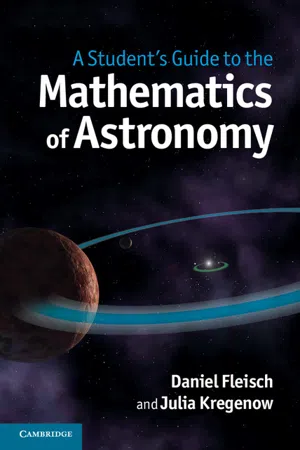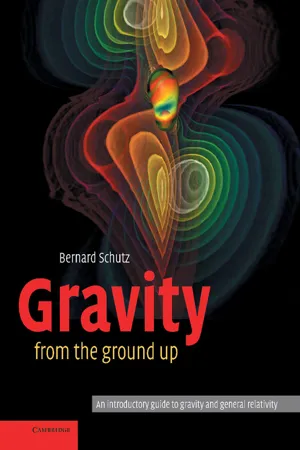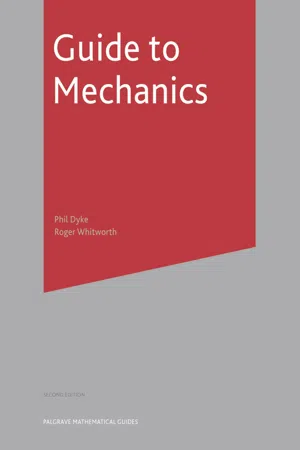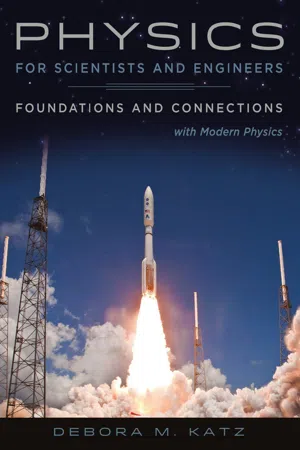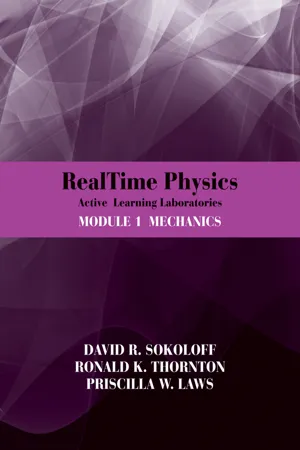Physics
Acceleration Due to Gravity
Acceleration due to gravity is the rate at which an object accelerates towards the Earth due to gravity. Near the surface of the Earth, this acceleration is approximately 9.81 meters per second squared. It is a constant value for a given location and is a fundamental concept in physics, influencing the motion of objects in free fall.
Written by Perlego with AI-assistance
Related key terms
1 of 5
8 Key excerpts on "Acceleration Due to Gravity"
- eBook - PDF
Workshop Physics Activity Guide Module 1
Mechanics I
- Priscilla W. Laws, David P. Jackson, Brett J. Pearson(Authors)
- 2023(Publication Date)
- Wiley(Publisher)
First, recall that the sign is related to the direction of the acceleration, which depends on the coordinate system we choose. The motion sensor defines the pos- itive direction as pointing up in this experiment. Therefore, a negative acceler- ation tells us that the acceleration vector points down. Second, the measured acceleration may not be exactly what you expected. The reason for this dis- agreement is likely due to air resistance on the ball’s motion; it can be surpris- ingly challenging to record free-fall data that is not affected by air resistance to some degree. 2 Third, the phrase “Acceleration Due to Gravity” can lead to mis- conceptions about how the gravitational force acts on objects. A better phrase might be “free-fall acceleration,” but even this has its problems. What we really need to understand is the gravitational force and how this force relates to the acceleration. Wests/Getty images 6.4 THE GRAVITATIONAL FORCE In the previous activity, we saw that a ball experiences an acceleration without the aid of a visible, applied force. However, if we believe Newton’s second law to be true—and we do!—then the fact that the object accelerates implies that there must be a force acting on the object. We call this the gravitational force. More specifically, because this force seems to emanate from Earth, we call it the gravitational force of Earth acting on the ball. Our task in this section is to investigate this gravitational force. For now, we will only consider the gravi- tational force near the surface of Earth. 2 Any object, including a basketball, will be affected by air resistance to some degree, but air resistance can be minimized by choosing a smaller, heavier object. Probably the best one can do in a classroom setting is to use a bowling ball. Of course, one must be extremely careful when tossing a bowling ball, as it can do serious damage if it lands on a motion sensor or someone’s foot! - Thais Russomano, Gustavo Dalmarco, Felipe Prehn Falcao(Authors)
- 2022(Publication Date)
- Springer(Publisher)
Gravitation is also responsible for keeping the Earth and the other planets in their orbits around the sun, the Moon in its orbit around the Earth, the formation of tides, and various other natural phenomena that are commonly observed (Figure 1.1). Gravity, however, is the gravitation related to Earth. It is then the gravitational force that occurs between the Earth and other bodies, the force acting to pull objects toward the Earth. It is expressed as 1G (capital “G,” as opposed to the acceleration g). Bodies with less mass than the Earth will have values lower than 1G (the Moon has 1/6G), and bodies with mass bigger than the Earth will have values higher than 1G (planet Jupiter has 3.5G). C H A P T E R 1 General Concepts in Physics— Definition of Physical Terms 2 EFFECTS OF HYPER- AND MICROGRAVITY ON BIOMEDICAL EXPERIMENTS Mass is a property of a physical object that quantifies the amount of matter and energy it is equivalent to and is expressed by the symbol m. Acceleration (expressed by the symbol a) is defined as the rate of change of velocity. It is thus a vector quantity with dimension length/time² (SI units m/s²), and the instantaneous accelera- tion of an objection is given by Equation 1.1. By being a vector, it must be described with both a direction and a magnitude. It can have positive and negative values — called acceleration (increasing speed) and deceleration (decreasing speed), respectively, as well as change in direction. a dv dt (1.1) where a is acceleration, v is velocity, t is time, and d is Leibniz’s notation for differentiation. Gravitation is one of the four fundamental interactions in nature, the other three being the electromagnetic force, the weak nuclear force, and the strong nuclear force. Compared to the other three fundamental interactions in nature, gravitation is the weakest one. It, however, acts over great distances and is always present. Gravitation is interpreted differently by classic mechanics, relativity, and quantum physics.- Daniel Fleisch, Julia Kregenow(Authors)
- 2013(Publication Date)
- Cambridge University Press(Publisher)
54 Gravity Using F g as the force in Newton’s Second Law gives a = F g m 1 = G m 1 m 2 R 2 m 1 = G m 1 m 2 R 2 m 1 = G m 2 R 2 . (2.4) So the acceleration of m 1 due to the force of gravity depends only on the mass of the other object ( m 2 ) and its distance – not on the amount of mass of the object itself ( m 1 ). That’s why, in the absence of other forces such as air resistance, all objects fall to Earth with the same acceleration regardless of their mass. How can this possibly be true? Shouldn’t an object with bigger mass fall faster, since the gravitational force between that object and Earth is greater? Well, it’s true that objects with greater mass experience a greater gravita-tional force from the Earth, but remember Newton’s Second Law: objects with greater mass resist acceleration more than objects with less mass (that is, more-massive objects have greater inertia). So, although the gravitational force is directly proportional to mass, acceleration is inversely proportional to mass, and combining these dependencies means that the acceleration of an object due to gravity does not depend on the object’s mass. To find the acceleration of an object near the surface of the Earth, just plug the values for the Earth’s mass and radius into Eq. 2.4 : a = G m Earth R 2 Earth = 6 . 67 × 10 − 11 N m 2 kg 2 6 × 10 24 kg ( 6 . 38 × 10 6 m ) 2 = 9 . 8 m s 2 . If you don’t see how the units work out in this equation, remember that newtons are equivalent to kg m/s 2 , as discussed in Section 1.1.6 . So, near the surface of the Earth, all objects experience the same acceler-ation due to gravity. In some texts, this gravitational acceleration is called g , which you should be careful not to confuse with G , the universal gravitational constant. Here are some exercises to check your understanding of Newton’s Laws of Motion; you’ll find additional problems at the end of this chapter.- eBook - PDF
Gravity from the Ground Up
An Introductory Guide to Gravity and General Relativity
- Bernard Schutz(Author)
- 2003(Publication Date)
- Cambridge University Press(Publisher)
We can prove that by measuring it. We have to accept the world the way we find it. This was the first step towards what we now call the principle of equivalence, which essentially asserts that gravity is indistinguishable from uniform accleration. We shall see that this principle has a remarkable number of consequences, from the weightlessness of astronauts to the possibility of black holes. The acceleration of gravity is uniform 3 Investigation 1.1. Faster and faster: the meaning of uniform acceleration In this investigation, we work out what Galileo’s law of constant ac- celeration means for the speed of a falling body. The calculation is short, and it introduces us to the way we will use some mathematical symbols through the rest of the book. We shall denote time by the letter t and the speed of the falling body by v (for velocity). The speed at time t will be written v (t ). The acceleration of the body is g, and it is constant in time. Suppose the body is dropped from rest at time t = 0. Then its initial speed is v = 0 at time t = 0, in other words v (0) = 0. What will be its speed a short time later? Let us call this later time ∆t . Here we meet an important new nota- tion: the symbol ∆ will always mean “a change in” whatever symbol follows it. Thus, a change in time is ∆t . Similarly, we shall call the change in speed produced by gravity ∆v . Normally we shall use this notation to denote small changes; here, for example, I have defined ∆t to be “a short time later”. We shall ask below how small ∆t has to be in order to be “short”. The acceleration g is the change in the speed per unit time. This definition can be written algebraically as g = ∆v ∆t . (1.1) By multiplying through by the denominator of the fraction, we can solve for the change in speed: ∆v = g∆t . (1.2) Equation 1.1 basically defines g to be the average acceleration during the time ∆t . If we take ∆t to be very small, then this gives what we generally call the instantaneous acceleration. - eBook - PDF
- Philip Dyke, Roger Whitworth(Authors)
- 2017(Publication Date)
- Red Globe Press(Publisher)
Figure 5.1 shows a particle in motion under gravity. For now, we neglect air resistance, so that the only force acting is gravity itself. Gravity is assumed to be constant, hence this is a special case of motion under constant acceleration, which was dealt with in Chapter 1. Let us derive the equation of motion for the simple system shown in Figure 5.1. Note that we have chosen the x -axis to point in the opposite direction to the force due to gravity; therefore: mg m acceleration 5 : 1 99 x m O Figure 5.1 A falling particle (apple?) We recall that acceleration can be expressed in a number of different forms, so we need to select one that is convenient for our particular problem. You should use d v = d t if you are interested in obtaining velocity as a function of time, and v d v = d x if you are interested in obtaining velocity as a function of distance. Finally you should use d 2 x = d t 2 and integrate twice if you want displacement (distance above ground) as a function of time. Our equation of motion, after cancelling the mass m from both sides, is thus one of the following: d v d t g v d v d x g d 2 x d t 2 g 5 : 2 In order to become adept at choosing which of these equations to apply, we need to solve particular problems. Here are some examples that will help to focus these ideas. Example 5.1 An apple of mass 0.3 kg falls from a tree. Find (a) its velocity after 2 s, ignoring air resistance and assuming it has not hit the ground, and (b) the distance it travels. Solution (a) We wish to find v as a function of time, hence we use the first of the equations (5.2): 100 Guide to Mechanics d v d t g Integrating this with respect to time gives: v gt A where A is an arbitrary constant. We determine the value of A by using the condition that at time t 0, v 0. Hence, A 0. Taking g 9 : 81 m s 2 , we obtain: v gt 9 : 81 t 5 : 3 Hence for a particular time, v is completely determined. - No longer available |Learn more
Physics for Scientists and Engineers
Foundations and Connections, Extended Version with Modern Physics
- Debora Katz(Author)
- 2016(Publication Date)
- Cengage Learning EMEA(Publisher)
All Rights Reserved. May not be copied, scanned, or duplicated, in whole or in part. WCN 02-300 130 CHAPTER 5 Newton’s Laws of Motion 5-7 Some Specific Forces As you study physics, you will encounter many forces. You should expect to learn three things about each one: its source, its magnitude, and its direction. This section presents a partial list that will make our study of Newton’s laws less abstract. Gravity Near the Earth’s Surface Gravity, or the gravitational force (the two terms are synonymous), is the field force that keeps us on the surface of the Earth and keeps the planets in orbit around the Sun. In general, any two objects that have mass exert an attractive gravitational force on each other. The closer the objects are together, the stronger their gravitational attraction. The general gravitational force between any two bodies is described in Chapter 7. For now, let’s focus on the gravitational force exerted by the Earth on objects located near its surface. From Chapter 2, when an object is in free fall, the only force acting on it is grav- ity. Experiments show that in the absence of air resistance, all objects in free fall near the surface of the Earth have the same downward acceleration g. Because the Earth’s gravitational force F u g is the only force acting on such an object, Newton’s second law for this situation is simply F u tot 5 F u g 5 ma u (5.4) If we choose an upward-pointing y axis, we can represent the acceleration as a u 5 2g e ˆ (5.5) Substitute Equation 5.5 into Equation 5.4 to find the gravitational force acting on an object of mass m near the Earth’s surface: F u g 5 2mg e ˆ (5.6) The gravitational force is always attractive; that is, all objects are always pulled to- ward the center of the Earth. Because of its role in Equation 5.6, g is also known as the local Acceleration Due to Gravity. There is an intimate connection between gravity and what we call weight. - Available until 9 Apr |Learn more
- Carlos A. Smith, Scott W. Campbell(Authors)
- 2016(Publication Date)
- CRC Press(Publisher)
19 2 Objects in a Gravitational Field This chapter is essentially an extension of Chapter 1 in that it shows how basic physics helps in developing mathematical models, and how basic calculus helps in obtaining the analytical solutions of models. The chapter also shows a method to keep track of the equa-tions and unknowns while developing models; we strongly recommend the reader to use it. An object in a gravitational field (gravity acting on objects) is the topic of the chapter. As we mentioned in Chapter 1, any modeling starts by using a basic physical law, followed by equations describing physical elements and experimental facts of phenomena related to the physics of the system . In the case of objects in a gravitational field, the physical law that helps is Newton’s second law: F m a = where the arrows above the force F and the acceleration a indicate that these quantities are vectors (meaning that direction and magnitude must be specified). Because in this chapter we will only be considering forces acting on the object to be perpendicular to the ground, in the y direction, such as gravity, we write the law again as F m a y y = ∑ (2.1) The summation sign is used in F y when there is more than one force acting on the object. In modeling the systems in this chapter, we have to choose a direction, up or down, as pos-itive. In all cases, unless otherwise specified, the positive direction is the “up direction.” 2.1 An Example An object of 20 kg is held in the air 30 m above the ground and released; Figure 2.1 shows the setup. Develop the models that describe the velocity and position of the object as a function of time once it is released. As an object falls, the two most common forces acting on it are gravity and air resistance. - eBook - PDF
- David R. Sokoloff, Ronald K. Thornton, Priscilla W. Laws(Authors)
- 2012(Publication Date)
- Wiley(Publisher)
LAB 6: GRAVITATIONAL FORCES 127 LAB 6: GRAVITATIONAL FORCES Name Date Partners And thus Nature will be very conformable to herself and very simple, performing all the great Motions of the heavenly Bodies by the attraction of gravity . . . —Isaac Newton OBJECTIVES • To explore the nature of motion along a vertical line near the Earth’s surface. • To extend the explanatory power of Newton’s laws by inventing an invisible force (the gravitational force) that correctly accounts for the falling motion of objects observed near the Earth’s surface. • To examine the magnitude of the acceleration of a falling object under the in- fluence of the gravitational force near the Earth’s surface. • To examine the motion of an object along an inclined ramp under the influ- ence of the gravitational force. • To define weight and discover its relationship to mass. • To discover the origin of normal forces. OVERVIEW You began your study of Newtonian dynamics in Lab 3 by developing the concept of force. Initially, when asked to define forces, most people think of a force as an obvious push or pull, such as a punch to the jaw or the tug of a rubber band. By studying the acceleration that results from a force when little friction is present, we came up with a second definition of force as that which causes acceleration. These two alternative definitions of force do not always appear to be the same. Push- ing on a wall doesn’t seem to cause the wall to move. An object dropped close to the surface of the Earth accelerates and yet there is no visible push or pull on it. 128 REALTIME PHYSICS: MECHANICS The genius of Newton was to recognize that he could define net force or com- bined force as that which causes acceleration, and that if the obvious applied forces did not account for the degree of acceleration then there must be other “invisi- ble” forces present. A prime example of an invisible force is the gravitational force—the attraction of the Earth for objects.
Index pages curate the most relevant extracts from our library of academic textbooks. They’ve been created using an in-house natural language model (NLM), each adding context and meaning to key research topics.


